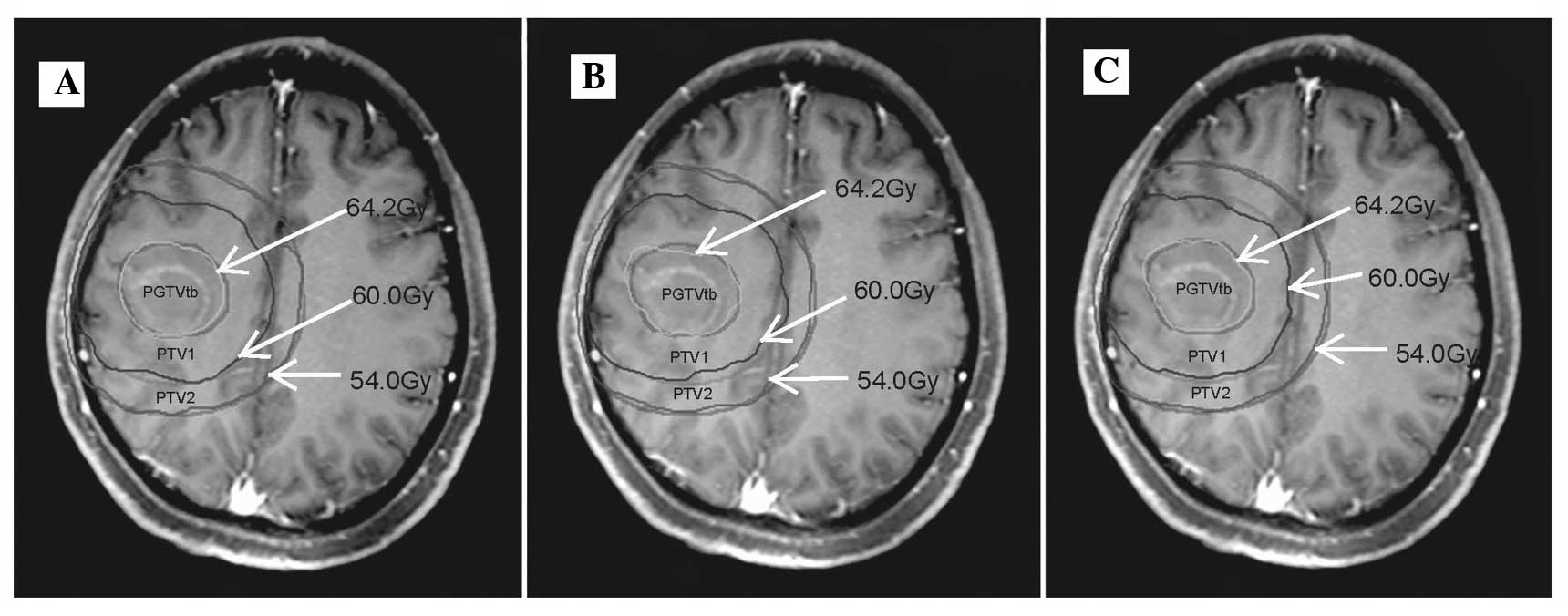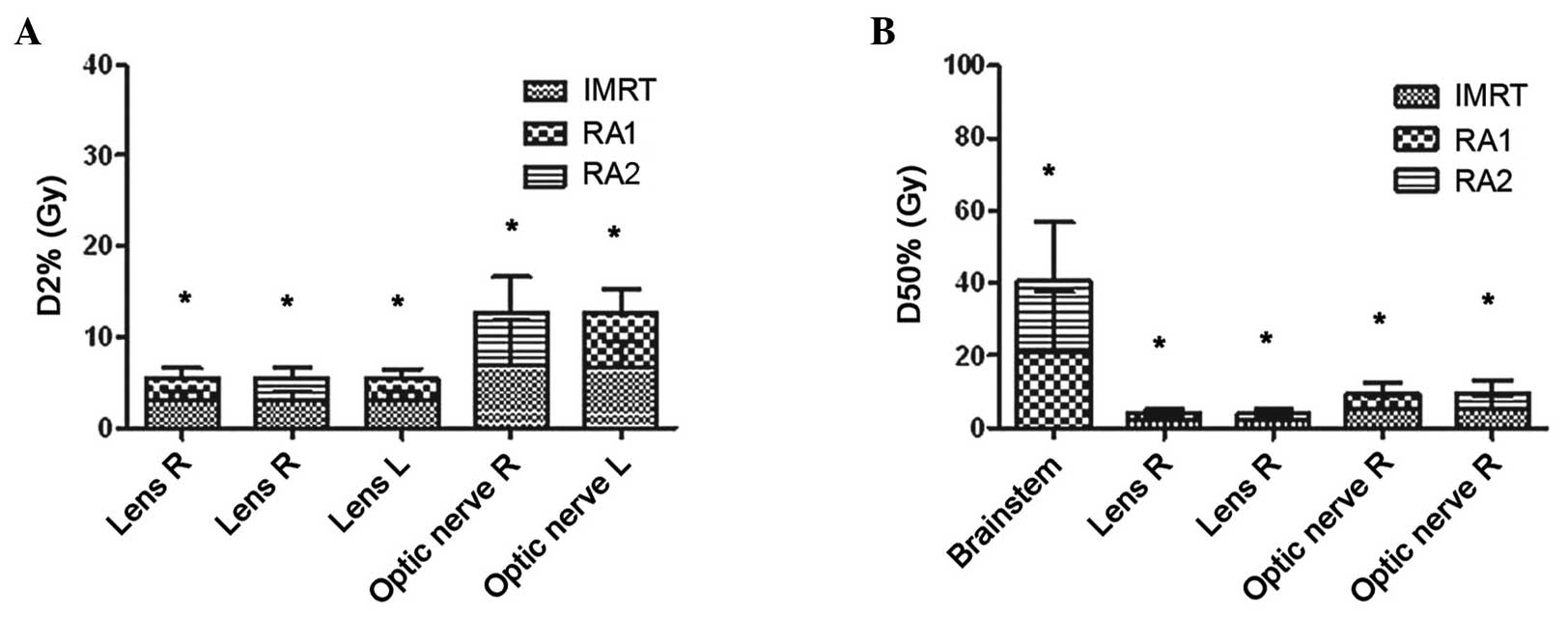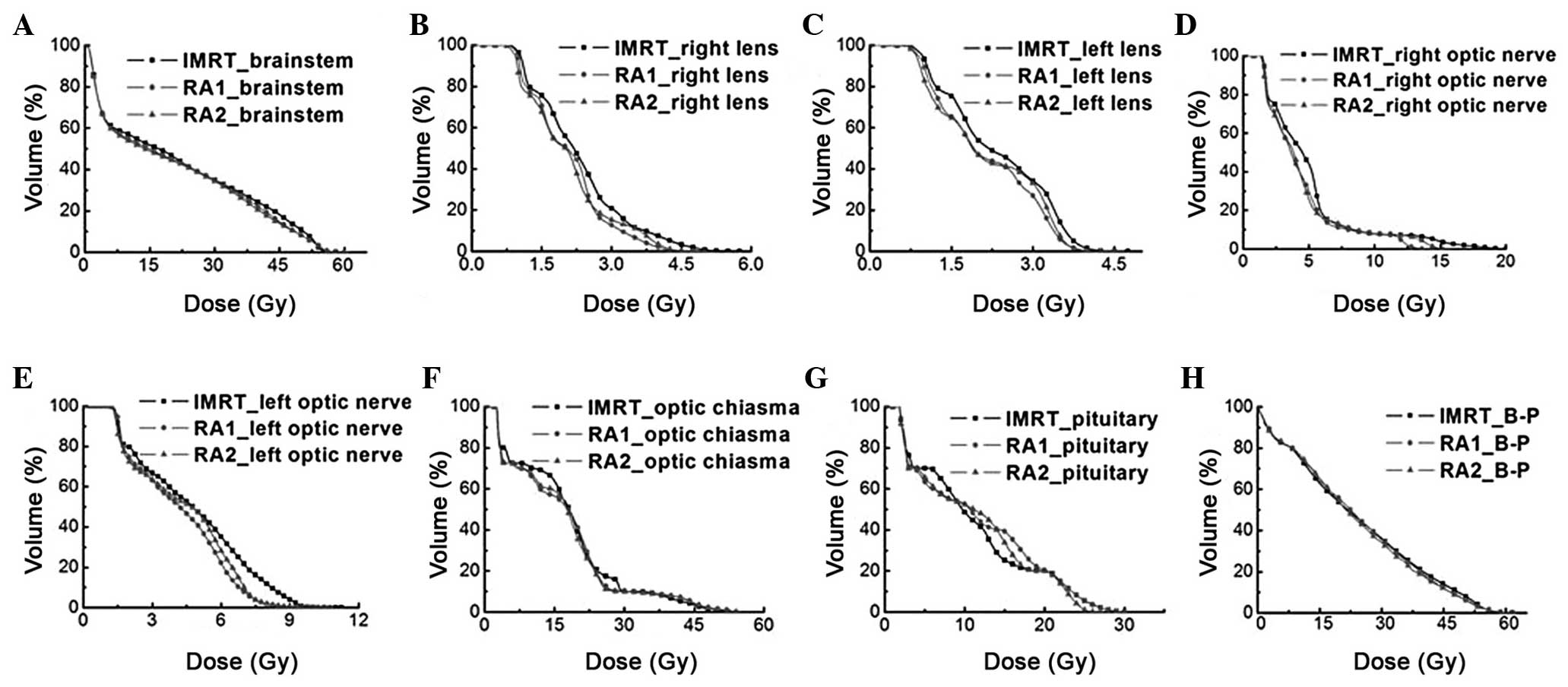|
1
|
MacDonald SM, Ahmad S, Kachris S, Vogds
BJ, DeRouen M, Gittleman AE, DeWyngaert K and Vlachaki MT:
Intensity modulated radiation therapy versus three-dimensional
conformal radiation therapy for the treatment of high grade glioma:
A dosimetric comparison. J Appl Clin Med Phys. 8:47–60.
2007.PubMed/NCBI
|
|
2
|
Lorentini S, Amelio D, Giri MG, Fellin F,
Meliado G, Rizzotti A, Amichetti M and Schwarz M: IMRT or 3D-CRT in
glioblastoma? A dosimetric criterion for patient selection. Technol
Cancer Res Treat. 12:411–420. 2013.PubMed/NCBI
|
|
3
|
Shaffer R, Nichol AM, Vollans E, Fong M,
Nakano S, Moiseenko V, Schmuland M, Ma R, McKenzie M and Otto K: A
comparison of volumetric modulated arc therapy and conventional
intensity-modulated radiotherapy for frontal and temporal
high-grade gliomas. Int J Radiat Oncol Biol Phys. 76:1177–1184.
2010. View Article : Google Scholar : PubMed/NCBI
|
|
4
|
Panet-Raymond V, Ansbacher W, Zavgorodni
S, Bendorffe B, Nichol A, Truong PT, Beckham W and Vlachaki M:
Coplanar versus noncoplanar intensity-modulated radiation therapy
(IMRT) and volumetric-modulated arc therapy (VMAT) treatment
planning for fronto-temporal high-grade glioma. J Appl Clin Med
Phys. 13:38262012.PubMed/NCBI
|
|
5
|
Louis DN, Ohgaki H, Wiestler OD, Cavenee
WK, Burger PC, Jouvet A, Scheithauer BW and Kleihues P: The 2007
WHO classification of tumours of the central nervous system. Acta
Neuropathol. 114:97–109. 2007. View Article : Google Scholar : PubMed/NCBI
|
|
6
|
Stupp R, Mason WP, Van Den Bent MJ, Weller
M, Fisher B, Taphoorn MJ, Belanger K, Brandes AA, Marosi C, Bogdahn
U, et al: Radiotherapy plus concomitant and adjuvant temozolomide
for glioblastoma. N Engl J Med. 352:987–996. 2005. View Article : Google Scholar : PubMed/NCBI
|
|
7
|
Ali AN, Ogunleye T, Hardy CW, Shu HK,
Curran WJ and Crocker IR: Improved hippocampal dose with reduced
margin radiotherapy for glioblastoma multiforme. Radiat Oncol.
9:202014. View Article : Google Scholar : PubMed/NCBI
|
|
8
|
Chui CS, LoSasso T and Spirou S: Dose
calculation for photon beams with intensity modulation generated by
dynamic jaw or multileaf collimations. Med Phys. 21:1237–1244.
1994. View
Article : Google Scholar : PubMed/NCBI
|
|
9
|
Spirou SV and Chui C-S: A gradient inverse
planning algorithm with dose-volume constraints. Med Phys.
25:321–333. 1998. View
Article : Google Scholar : PubMed/NCBI
|
|
10
|
Bragg CM, Wingate K and Conway J: Clinical
implications of the anisotropic analytical algorithm for IMRT
treatment planning and verification. Radiother Oncol. 86:276–284.
2008. View Article : Google Scholar : PubMed/NCBI
|
|
11
|
Knöös T, Wieslander E, Cozzi L, Brink C,
Fogliata A, Albers D, Nyström H and Lassen S: Comparison of dose
calculation algorithms for treatment planning in external photon
beam therapy for clinical situations. Phys Med Biol. 51:5785–5807.
2006. View Article : Google Scholar : PubMed/NCBI
|
|
12
|
Ulmer W, Pyyry J and Kaissl W: A 3D photon
superposition/convolution algorithm and its foundation on results
of Monte Carlo calculations. Phys Med Biol. 50:1767–1790. 2005.
View Article : Google Scholar : PubMed/NCBI
|
|
13
|
Cozzi L, Dinshaw KA, Shrivastava SK,
Mahantshetty U, Engineer R, Deshpande DD, Jamema SV, Vanetti E,
Clivio A, Nicolini G and Fogliata A: A treatment planning study
comparing volumetric arc modulation with RapidArc and fixed field
IMRT for cervix uteri radiotherapy. Radiother Oncol. 89:180–191.
2008. View Article : Google Scholar : PubMed/NCBI
|
|
14
|
van't Riet A, Mak AC, Moerland MA, Elders
LH and van der Zee W: A conformation number to quantify the degree
of conformality in brachytherapy and external beam irradiation:
Application to the prostate. Int J Radiat Oncol Biol Phys.
37:731–736. 1997. View Article : Google Scholar : PubMed/NCBI
|
|
15
|
Wu Q, Mohan R, Morris M, Lauve A and
Schmidt-Ullrich R: Simultaneous integrated boost
intensity-modulated radiotherapy for locally advanced head-and-neck
squamous cell carcinomas. I: Dosimetric results. Int J Radiat Oncol
Biol Phys. 56:573–585. 2003. View Article : Google Scholar : PubMed/NCBI
|
|
16
|
Wagner D, Christiansen H, Wolff H and
Vorwerk H: Radiotherapy of malignant gliomas: Comparison of
volumetric single arc technique (RapidArc), dynamic
intensity-modulated technique and 3D conformal technique. Radiother
Oncol. 93:593–596. 2009. View Article : Google Scholar : PubMed/NCBI
|
|
17
|
Munck Af Rosenschöld P, Engelholm S,
Ohlhues L, Law I, Vogelius I and Engelholm SA: Photon and proton
therapy planning comparison for malignant glioma based on CT,
FDG-PET, DTI-MRI and fiber tracking. Acta Oncol. 50:777–783. 2011.
View Article : Google Scholar : PubMed/NCBI
|
|
18
|
Guckenberger M, Richter A, Krieger T,
Wilbert J, Baier K and Flentje M: Is a single arc sufficient in
volumetric-modulated arc therapy (VMAT) for complex-shaped target
volumes? Radiother Oncol. 93:259–265. 2009. View Article : Google Scholar : PubMed/NCBI
|
|
19
|
Palma DA, Verbakel WF, Otto K and Senan S:
New developments in arc radiation therapy: A review. Cancer Treat
Rev. 36:393–399. 2010. View Article : Google Scholar : PubMed/NCBI
|
|
20
|
Verbakel WF, Senan S, Cuijpers JP, Slotman
BJ and Lagerwaard FJ: Rapid delivery of stereotactic radiotherapy
for peripheral lung tumors using volumetric intensity-modulated
arcs. Radiother Oncol. 93:122–124. 2009. View Article : Google Scholar : PubMed/NCBI
|
|
21
|
Vanetti E, Clivio A, Nicolini G, Fogliata
A, Ghosh-Laskar S, Agarwal JP, Upreti RR, Budrukkar A, Murthy V,
Deshpande DD, et al: Volumetric modulated arc radiotherapy for
carcinomas of the oro-pharynx, hypo-pharynx and larynx: A treatment
planning comparison with fixed field IMRT. Radiother Oncol.
92:111–117. 2009. View Article : Google Scholar : PubMed/NCBI
|
|
22
|
Clivio A, Fogliata A, Franzetti-Pellanda
A, Nicolini G, Vanetti E, Wyttenbach R and Cozzi L:
Volumetric-modulated arc radiotherapy for carcinomas of the anal
canal: A treatment planning comparison with fixed field IMRT.
Radiother Oncol. 92:118–124. 2009. View Article : Google Scholar : PubMed/NCBI
|
|
23
|
Ron E, Modan B, Boice JD Jr, Alfandary E,
Stovall M, Chetrit A and Katz L: Tumors of the brain and nervous
system after radiotherapy in childhood. N Engl J Med.
319:1033–1039. 1988. View Article : Google Scholar : PubMed/NCBI
|
|
24
|
Simmons NE and Laws ER Jr: Glioma
occurrence after sellar irradiation: Case report and review.
Neurosurgery. 42:172–178. 1998. View Article : Google Scholar : PubMed/NCBI
|
|
25
|
Tsang RW, Laperriere NJ, Simpson WJ,
Brierley J, Panzarella T and Smyth HS: Glioma arising after
radiation therapy for pituitary adenoma. A report of four patients
and estimation of risk. Cancer. 72:2227–2233. 1993. View Article : Google Scholar : PubMed/NCBI
|
|
26
|
Kaido T, Hoshida T, Uranishi R, Akita N,
Kotani A, Nishi N and Sakaki T: Radiosurgery-induced brain tumor.
Case report. J Neurosurg. 95:710–713. 2001. View Article : Google Scholar : PubMed/NCBI
|
|
27
|
Shamisa A, Bance M, Nag S, Tator C, Wong
S, Norén G and Guha A: Glioblastoma multiforme occurring in a
patient treated with gamma knife surgery. Case report and review of
the literature. J Neurosurg. 94:816–821. 2001. View Article : Google Scholar : PubMed/NCBI
|
|
28
|
Yu JS, Yong WH, Wilson D and Black KL:
Glioblastoma induction after radiosurgery for meningioma. Lancet.
356:1576–1577. 2000. View Article : Google Scholar : PubMed/NCBI
|
|
29
|
Neglia JP, Robison LL, Stovall M, Liu Y,
Packer RJ, Hammond S, Yasui Y, Kasper CE, Mertens AC, Donaldson SS,
et al: New primary neoplasms of the central nervous system in
survivors of childhood cancer: A report from the childhood cancer
survivor study. J Natl Cancer Inst. 98:1528–1537. 2006. View Article : Google Scholar : PubMed/NCBI
|
|
30
|
Relling MV, Rubnitz JE, Rivera GK, Boyett
JM, Hancock ML, Felix CA, Kun LE, Walter AW, Evans WE and Pui CH:
High incidence of secondary brain tumours after radiotherapy and
antimetabolites. Lancet. 354:34–39. 1999. View Article : Google Scholar : PubMed/NCBI
|
|
31
|
Walter AW, Hancock ML, Pui CH, Hudson MM,
Ochs JS, Rivera GK, Pratt CB, Boyett JM and Kun LE: Secondary brain
tumors in children treated for acute lymphoblastic leukemia at St
Jude Children's Research Hospital. J Clin Oncol. 16:3761–3767.
1998.PubMed/NCBI
|
|
32
|
Followill D, Geis P and Boyer A: Estimates
of whole-body dose equivalent produced by beam intensity modulated
conformal therapy. Int J Radiat Oncol Biol Phys. 38:667–672. 1997.
View Article : Google Scholar : PubMed/NCBI
|
|
33
|
Kry SF, Salehpour M, Followill DS, Stovall
M, Kuban DA, White RA and Rosen II: The calculated risk of fatal
secondary malignancies from intensity-modulated radiation therapy.
Int J Radiat Oncol Biol Phys. 62:1195–1203. 2005. View Article : Google Scholar : PubMed/NCBI
|
|
34
|
Hall EJ and Wuu CS: Radiation-induced
second cancers: The impact of 3D-CRT and IMRT. Int J Radiat Oncol
Biol Phys. 56:83–88. 2003. View Article : Google Scholar : PubMed/NCBI
|
|
35
|
Gershkevitsh E, Clark CH, Staffurth J,
Dearnaley DP and Trott KR: Dose to bone marrow using IMRT
techniques in prostate cancer patients. Strahlenther Onkol.
181:172–178. 2005. View Article : Google Scholar : PubMed/NCBI
|
|
36
|
Halperin EC, Perez CA and Brady LW:
Principles and Practice of Radiation Oncology (5th). 730,
Lippincott Williams & Wilkins. 2008.
|
|
37
|
Corn BW, Yousem DM, Scott CB, Rotman M,
Asbell SO, Nelson DF, Martin L and Curran WJ Jr: White matter
changes are correlated significantly with radiation dose.
Observations from a randomized dose-escalation trial for malignant
glioma (Radiation therapy oncology group 83-02). Cancer.
74:2828–2835. 1994. View Article : Google Scholar : PubMed/NCBI
|
|
38
|
Wang JZ, Li XA, D'Souza WD and Stewart RD:
Impact of prolonged fraction delivery times on tumor control: A
note of caution for intensity-modulated radiation therapy (IMRT).
Int J Radiat Oncol Biol Phys. 57:543–552. 2003. View Article : Google Scholar : PubMed/NCBI
|
|
39
|
Teoh M, Clark CH, Wood K, Whitaker S and
Nisbet A: Volumetric modulated arc therapy: A review of current
literature and clinical use in practice. Br J Radiol. 84:967–996.
2011. View Article : Google Scholar : PubMed/NCBI
|












